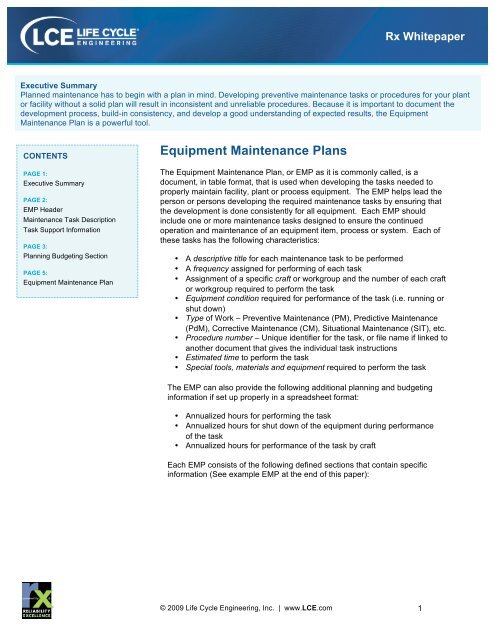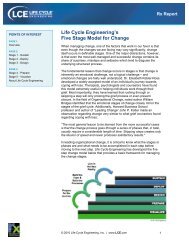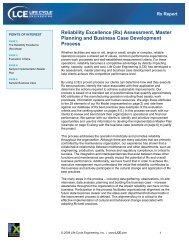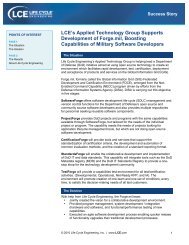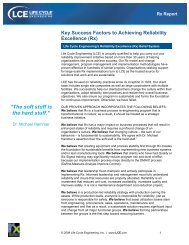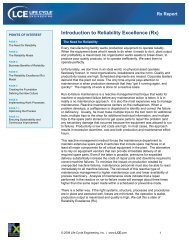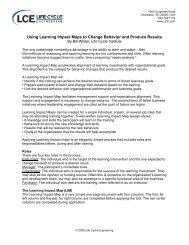Equipment Maintenance Plans - Life Cycle Engineering
Equipment Maintenance Plans - Life Cycle Engineering
Equipment Maintenance Plans - Life Cycle Engineering
Create successful ePaper yourself
Turn your PDF publications into a flip-book with our unique Google optimized e-Paper software.
Rx Whitepaper<br />
Executive Summary<br />
Planned maintenance has to begin with a plan in mind. Developing preventive maintenance tasks or procedures for your plant<br />
or facility without a solid plan will result in inconsistent and unreliable procedures. Because it is important to document the<br />
development process, build-in consistency, and develop a good understanding of expected results, the <strong>Equipment</strong><br />
<strong>Maintenance</strong> Plan is a powerful tool.<br />
CONTENTS<br />
PAGE 1:<br />
Executive Summary<br />
PAGE 2:<br />
EMP Header<br />
<strong>Maintenance</strong> Task Description<br />
Task Support Information<br />
PAGE 3:<br />
Planning Budgeting Section<br />
PAGE 5:<br />
<strong>Equipment</strong> <strong>Maintenance</strong> Plan<br />
<strong>Equipment</strong> <strong>Maintenance</strong> <strong>Plans</strong><br />
The <strong>Equipment</strong> <strong>Maintenance</strong> Plan, or EMP as it is commonly called, is a<br />
document, in table format, that is used when developing the tasks needed to<br />
properly maintain facility, plant or process equipment. The EMP helps lead the<br />
person or persons developing the required maintenance tasks by ensuring that<br />
the development is done consistently for all equipment. Each EMP should<br />
include one or more maintenance tasks designed to ensure the continued<br />
operation and maintenance of an equipment item, process or system. Each of<br />
these tasks has the following characteristics:<br />
• A descriptive title for each maintenance task to be performed<br />
• A frequency assigned for performing of each task<br />
• Assignment of a specific craft or workgroup and the number of each craft<br />
or workgroup required to perform the task<br />
• <strong>Equipment</strong> condition required for performance of the task (i.e. running or<br />
shut down)<br />
• Type of Work – Preventive <strong>Maintenance</strong> (PM), Predictive <strong>Maintenance</strong><br />
(PdM), Corrective <strong>Maintenance</strong> (CM), Situational <strong>Maintenance</strong> (SIT), etc.<br />
• Procedure number – Unique identifier for the task, or file name if linked to<br />
another document that gives the individual task instructions<br />
• Estimated time to perform the task<br />
• Special tools, materials and equipment required to perform the task<br />
The EMP can also provide the following additional planning and budgeting<br />
information if set up properly in a spreadsheet format:<br />
• Annualized hours for performing the task<br />
• Annualized hours for shut down of the equipment during performance<br />
of the task<br />
• Annualized hours for performance of the task by craft<br />
Each EMP consists of the following defined sections that contain specific<br />
information (See example EMP at the end of this paper):<br />
© 2009 <strong>Life</strong> <strong>Cycle</strong> <strong>Engineering</strong>, Inc. | www.LCE.com 1
EMP Header<br />
• <strong>Equipment</strong> Type – this identifies the equipment type or class to which the<br />
maintenance tasks apply, i.e. fans, centrifugal pumps, belt conveyors, etc.<br />
• Description – identifies the specific equipment that is covered by the EMP,<br />
usually the equipment number and description, as listed in the CMMS is<br />
used here<br />
• Location – number identifies the physical location of the equipment within<br />
the plant or facility<br />
• Documentation – number lists what technical documentation is available<br />
and where it is stored or maintained<br />
• Validated – this area requires a "yes" or "no" indication of whether or not<br />
the equipment nameplate data has been validated<br />
<strong>Maintenance</strong> Task Description<br />
• Item number – identifies each of the maintenance tasks listed on the<br />
EMP, giving each a line item number<br />
• <strong>Maintenance</strong> task description - this area is where the very brief<br />
description of the work to be performed is entered, i.e. Clean and lubricate<br />
pump, inspect and lubricate fan, etc.<br />
• Frequency - identifies the frequency at which the maintenance task is to<br />
be performed, i.e. 7 days, 30 days, 90 days, 180 days, 365 days, etc.<br />
Usually days are used, rather than weekly, monthly, quarterly, etc. Meterbased<br />
frequencies can also be used, i.e. 100 Hrs, 500 Hrs, etc.<br />
Situational frequencies based on inspection results can also be included<br />
Task Support Information<br />
• Craft - identifies the type of craft or skill required to perform the<br />
maintenance task, i.e. MECH, ELECT, CONTR, etc.<br />
• Craftsmen required - indicates the number of crafts persons required to<br />
perform the maintenance<br />
• <strong>Equipment</strong> condition – indicates if the equipment must be running or shut<br />
down when certain maintenance tasks are performed<br />
• Type - the type of maintenance task is entered here, i.e. PM, PdM, CM,<br />
etc.<br />
• Procedure/Task number – the unique procedure or task number is<br />
entered here; typically this will be the unique identifier used in a CMMS or<br />
a file name.<br />
• Est. time (Hrs) – this is where the estimated time to complete the task is<br />
entered. This is an educated estimate based on previous experience or<br />
established estimating standards.<br />
• Special tools/Materials/Remarks - identifies any special tools not usually<br />
carried in a craftsman's toolbox, i.e., torque wrenches, man-lifts, ladders,<br />
etc. or a hazardous waste container, personal protective equipment, etc.,<br />
and any additional remarks that apply specifically to performing the task.<br />
© 2009 <strong>Life</strong> <strong>Cycle</strong> <strong>Engineering</strong>, Inc. | www.LCE.com 2
Planning/Budgeting Section<br />
• Annual (Hrs) – used to calculate the total annual hours required to<br />
perform each specific maintenance task<br />
• Annual Scheduled <strong>Maintenance</strong> Hrs – used to total all the annual hours<br />
required to perform all the maintenance tasks listed on the EMP<br />
• Annual Shutdown Hrs – Used to calculate the required hours of shutdown<br />
needed to perform all the maintenance tasks listed on the EMP<br />
• Annual Operator Hrs – Used to calculate the total hours of operator time<br />
needed to perform the maintenance tasks listed on the EMP<br />
• Annual Mechanic Hrs – Used to calculate the total hours of mechanic time<br />
needed to perform the maintenance tasks listed on the EMP<br />
• Annual Electrician Hrs – Used to calculate the total hours of electrician<br />
time needed to perform the maintenance tasks listed on the EMP<br />
• Annual Contractor Hrs – Used to calculate the total hours of contractor<br />
time needed to perform the maintenance tasks listed on the EMP.<br />
You can develop an EMP for each equipment item, type of equipment or system.<br />
It is generally best to develop the EMP for each type or class of equipment and<br />
then apply the identified maintenance to all the equipment you have that is of the<br />
same type or class. When you have the same type of equipment, but in different<br />
operating environments, you may want to develop separate EMPs for each of<br />
them and apply different frequencies, man-hours and special tools/materials to<br />
each. The EMP is a very flexible document and can be used to accommodate<br />
almost any need for maintenance requirement development. Use it the way it<br />
best fits your needs and specific requirements.<br />
When developing EMPs you are defining the tasks or procedures and all<br />
associated information needed for to properly maintain your equipment. You<br />
must first determine what equipment you want to include in the maintenance<br />
program and develop EMPs for those equipment items. Consider the criticality of<br />
your equipment before you start and develop EMPs for the most critical<br />
equipment first.<br />
Once you know what equipment you will be including in the maintenance<br />
program you need to gather the needed information to develop the required<br />
maintenance. Gather the equipment information that you want to include in your<br />
maintenance records. This generally includes the equipment nameplate data,<br />
including manufacturer, model number, serial number, electrical characteristics,<br />
specifications, operating parameters, etc. It is always best to get as much<br />
information directly off the equipment nameplate as possible because vendor<br />
manuals, equipment drawings, etc. do not usually provide all the useable<br />
information and many times it is not accurate.<br />
Next, you need to gather the documentation available for the equipment. This is<br />
generally vendor operation and maintenance manuals, catalog cuts, shop<br />
drawings, construction drawings, P&IDs, parts lists, and exploded views. You<br />
need these to develop the equipment-specific maintenance tasks, and special<br />
tools and materials list.<br />
© 2009 <strong>Life</strong> <strong>Cycle</strong> <strong>Engineering</strong>, Inc. | www.LCE.com 3
It is always best to consider the manufacturer's recommended maintenance for<br />
equipment, but you must also consider the equipments operating environment is<br />
and the frequency of operation. You would not want to change the oil in the<br />
pedestal of a pump on a quarterly frequency if the pump is in a clean<br />
environment and is operated very infrequently. Nor would you want to change the<br />
oil in an engine on an annual basis if the engine runs very frequently and is in a<br />
harsh environment. You must consider the operating context of the equipment<br />
and make informed decisions on maintenance needs.<br />
After you have determined the maintenance tasks that need to be performed, the<br />
next thing to include on the EMP is the skilled craft required to perform the<br />
maintenance. These crafts or skills are generally the same as those employed at<br />
the facility or plant. It is not unusual, though, to include maintenance tasks that<br />
require skills that are not available in house and must be contracted out. For<br />
these you may enter "CONT" or another code for the contracted craft<br />
designation.<br />
The number of craftsmen needed is also important. If more than one person is<br />
needed it must be identified and included so the man-hours calculated for the<br />
year will reflect using the extra personnel. Although some tasks must be multicraft,<br />
it is recommended that each maintenance task be developed for a specific<br />
craft. Develop single craft requirements, and then schedule multi-crafts together<br />
as required.<br />
Identify and include in the “TYPE” column the type of maintenance, for example,<br />
preventive (PM), corrective (CM), predictive (PdM) and situational (SIT) (based<br />
on meter hours, analysis results, special events, etc.)<br />
If you are assigning unique procedure/task codes or numbers to each<br />
maintenance procedure the first thing to decide is the format for these numbers<br />
or codes. It is extremely important to only use codes that can be accepted by<br />
your computerized maintenance management system or work order system.<br />
Even if you do not have to meet the criteria for a computer program it is important<br />
to use a consistent and logical number or code that is easily recognized.<br />
An estimated time required to perform the maintenance task is used to determine<br />
what the annual man-hour requirement will be for planning and budgeting. This<br />
estimated time should include the total time it will take to perform the<br />
maintenance action. Only enter the time it would take for one person to do his<br />
part of the work. If you are using a spreadsheet to develop the EMP, and the<br />
formulas are set up correctly, the time will be multiplied by the number of<br />
craftsmen and the frequency to determine the annual man-hours.<br />
The special tools and materials that are required to perform the maintenance<br />
also need to be captured and included on the EMP. These can be as simple as<br />
the need for a torque wrench that is not normally found in the mechanics toolbox.<br />
These can also be major items like a man-lift, refrigerant recovery machine,<br />
boiler combustion test kit, etc.<br />
© 2009 <strong>Life</strong> <strong>Cycle</strong> <strong>Engineering</strong>, Inc. | www.LCE.com 4
The planning and budgeting section of the EMP should include the right<br />
information for maintenance tasks listed on the specific EMP. For example, you<br />
do not want to list annual operator’s hours in this section unless you have<br />
identified operators as the craft required for a maintenance task. It is also<br />
important to change your formulas as necessary if you are using them for<br />
automatic calculations in a spreadsheet application.<br />
You now have all the valuable information needed to develop your planned<br />
maintenance tasks and planning and budgeting for those actions in one location.<br />
To find out more about implementing Rx in your organization, please email us at<br />
info@LCE.com or call 843-744-7110.<br />
© 2009 <strong>Life</strong> <strong>Cycle</strong> <strong>Engineering</strong>, Inc. | www.LCE.com 5


